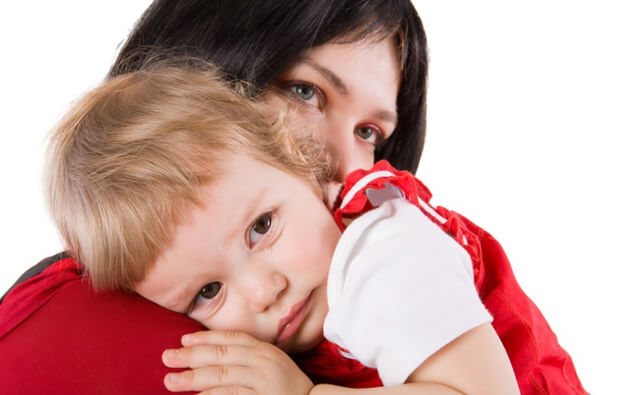Causes of symptoms in children
Gastroesophageal reflux is the backflow of stomach contents into the esophagus. Vomit appears periodically and in most cases has a sour smell. Symptoms of the disorder are accompanied by anxiety in the baby and frequent attacks of suffocation. The child does not gain weight well and coughs in the morning. If the disease is not treated in time, the patient experiences heartburn, severe snoring at night and unpleasant belching. Tooth enamel is destroyed.
The main causes of vomiting and stool disorders are:
- pylorospasm;
- pyloric stenosis;
- intestinal obstruction;
- nutritional gastritis + food poisoning. The inflammatory process develops against the background of poor quality nutrition;
- pancreatic disorder and acute appendicitis;
- gallbladder disease (including cholecystitis);
- introduction of complementary foods;
- disruptions in the functioning of the central nervous system.
Causes of vomiting without diarrhea and accompanying symptoms
Of course, there is absolutely no need for parents to know all the clinical symptoms with laboratory parameters and diagnostic and treatment regimens, but it is necessary to understand and at least assume what could have caused such symptoms.
Typically, vomiting without diarrhea or fever can indicate diseases of the gastrointestinal tract, a reflex to something (functional vomiting), diseases of the nervous system, or a pathological reaction to taking medications.
In general, all causes can be reduced to infectious and non-infectious.
Here are the main diseases that can be accompanied by vomiting without accompanying symptoms.
Pylorospasm
Pylorospasm is a spasm that occurs in the pyloric part of the stomach, in particular in the pylorus. As a result of this spasm, complete physiological emptying of the stomach becomes impossible, food accumulates and at a certain moment it begins to be released back through an accessible opening - the mouth.
The most typical symptom is nausea, followed by vomiting. Usually it manifests itself from the first days of life. It is not abundant, periodic, with undigested or semi-digested contents. Symptoms similar to these also occur during poisoning, so you need to consult a doctor so as not to miss a spasm.
Pyloric stenosis
If pyloric spasm is a functional disorder and does not affect the anatomy of the stomach, then pyloric stenosis is a congenital malformation of the very pyloric part of the stomach. The pathology consists of pathological thickening of the muscle layer. As a result, the diameter narrows and the passage of food further along the gastrointestinal tract becomes impossible.
The first signs appear on the third day of the child’s life and are very frightening for parents. Fountain vomiting begins. There are no pathological impurities in the contents of the vomit, but what is eaten comes out in practically unchanged quantity and form.
The child begins to lose a lot of weight and become dehydrated. A striking symptom is the sinking of the fontanelle. There is no high fever or diarrhea.
Acute appendicitis
Appendicitis is an inflammation of the appendix of the cecum, of as yet unknown etiology. It is generally accepted that appendicitis is characterized by sharp and nagging pain in the right iliac region, but this is not always the case.
In some people, the intestine goes in the opposite direction, and the appendix is located on the left. Sometimes the process comes into contact with the mesentery and then the pain can be diffuse. That is why you should not do anything on your own if you have abdominal pain.

In addition to pain, children may have other symptoms during appendicitis:
- anxiety;
- lack of appetite;
- nausea and repeated vomiting;
- temperature rise to 38-39 degrees;
- sometimes – the urge to defecate and frequent urination.
In this case, distinguishing appendicitis from cholecystitis or pyelonephritis is a task of first importance, and only an experienced specialist can do this.
Intussusception
Many people underestimate the importance of properly introducing complementary foods into a baby’s diet, and in vain. If difficult-to-digest foods were introduced too early or the diet does not allow the body to gradually absorb food, peristalsis is disrupted and one part of the intestine is pressed into another. This is called intussusception. It develops mainly between the ages of 6 months and one year.
Among the characteristic symptoms of intussusception:
- sharp, cramping pain;
- no abnormal bowel movements or temperature;
- anxiety;
- screaming and crying for no apparent reason;
- attacks of nausea and vomiting.
Intussusception is a serious pathology that has a direct danger to the child’s life.
Foreign body
A foreign body can enter a child’s digestive tract if it is swallowed and gets stuck in the esophagus. Irritation of the mucous membrane causes the formation of large amounts of mucus and rhythmic contractions of the smooth muscles of the esophagus.
Typically, the gag reflex occurs within a few minutes after swallowing a foreign object. In addition to vomiting, respiratory distress and copious mucus secretion are often observed. There is usually no temperature.
Neurological pathology
Vomiting caused by neurological diseases (so-called cerebral vomiting) is different in that it does not bring relief and does not have any objective diagnostic indicators for the gastrointestinal tract or kidneys. Typically, cerebral vomiting is accompanied by migraines, drowsiness and weakness. There are usually no symptoms of intoxication (fever, diarrhea).

Food poisoning
Foodborne illness is the entry of bacteria or protozoan microorganisms into the digestive tract along with food or drinks. Usually, when poisoning occurs, other symptoms appear, such as weakness and abdominal pain. Sometimes there is an increase in temperature.
But there may also be a specific reaction - just nausea and vomiting. Usually it is reusable, abundant, with remnants of undigested food, mucus, and sometimes even blood. Particular attention should be paid to the appearance of vomit.
First aid for vomiting and diarrhea in children
Treatment of diarrhea and vomiting in a child without a high fever should be carried out without delay. Algorithm of actions:
- Call an ambulance to your home.
- After each vomiting process, rinse your baby's mouth.
- Give your baby plenty of fluids for the first 6 hours after diarrhea.
- Soldering is done with solutions based on water and salt (Regidron, Glucosolan). To do this, dilute 5 tsp in 1 liter of boiled water. granulated sugar. The elixir is consumed every 10 minutes. The pipette is suitable for infants.
- Green tea and dried compote are excellent as a generous drink. Drinks will help get rid of hiccups.
- Rectal suppositories are used to bring down the temperature. For children over 1 year old, special suspensions are used. If the child is weak, he should rest.
- To psychologically calm the baby, put him to the breast more often.
Until doctors arrive, it is recommended to save the child’s vomit and excrement. The doctor will be able to visually examine the biomaterial. When the patient is hospitalized, precise studies are carried out. Identifying the causes of the disorder will allow you to choose the optimal treatment regimen.
First aid for bloody diarrhea
What to do if a child has bloody diarrhea? First of all, you need to call a doctor or ambulance. Before their arrival, to alleviate the condition and prevent dehydration, older children should alternately be given a little sweet tea and salted water every 5-10 minutes. Infants need to be put to the breast more often. It is also important to limit your food intake until further instructions from your doctor.
Vomiting is a common occurrence in many children, especially when rotavirus is present.
Blood in vomit is not always a symptom of a serious medical problem, but this condition definitely requires evaluation by a specialist.
Bloody vomiting is a medical emergency. Often the bleeding stops quite quickly, but sometimes it is serious and life-threatening. Therefore, call an ambulance or go directly to the nearest hospital if your child is vomiting blood.
Blood is usually present in vomit, either bright red in color or looking like dark brown coffee grounds.
Vomiting bright red blood means that bleeding began just before vomiting, while vomiting dark blood (often the color of coffee grounds) indicates that the blood has been in the stomach for some time and the iron in the blood has been oxidized by stomach acids.
What to feed your baby
The best food for a baby is mother's milk. For older babies (from 6 months), thin porridge made from buckwheat or rice is suitable. Cereals should be cooked using 1 part milk and 1 part water. After a couple of days, boiled vegetables in the form of purees and fruit juices are introduced into the diet.
Jelly has excellent properties for an irritated stomach. The drink envelops the mucous membrane. Children are given soaked crackers from white bread or a loaf.
In case of severe vomiting and diarrhea without fever in children, you should focus on the following products:
- dried fruits compote;
- boiled carrots + broccoli;
- baked apples;
- banana + fresh kefir;
- natural yoghurts without chemical fillers.
Do not feed your child meat, fish (foods with protein), egg omelettes and dairy products. Barley and wheat porridges are not suitable. Raw vegetables and most fruits are contraindicated.
How does vomiting occur?
In both adults and children, when the vomiting center in the medulla oblongata is excited, vomiting begins. From the kidneys, stomach, intestines, vestibular apparatus and other organs, impulses enter the brain, stimulating the vomiting center.
Excitation of nerve centers acts in a similar way. For example, if a child smells an unpleasant, pungent odor, he may start vomiting. Often, stimulation of the vomiting center occurs under the influence of toxic substances and medications.
Before vomiting, nausea most often appears, the heart rate increases, breathing becomes fast and intermittent, and salivation increases. When the gag reflex occurs, the diaphragm lowers, the glottis closes (to prevent vomit from entering the respiratory tract), the lower section of the stomach contracts, and the upper section relaxes. The muscles of the diaphragm and abdominal muscles contract, the contents of the stomach are expelled, and vomiting occurs.
When to see a doctor
In most cases, symptoms of intestinal flu in children go away without complications. Dr. Komarovsky advises seeking help from a doctor if the following factors occur:
- the baby vomits every 12 hours and has diarrhea five times a day;
- signs of dehydration + nausea;
- the total duration of the illness without fever exceeds 3 days;
- blood and mucus are observed in the excrement;
- allergies are observed during treatment and feeding;
- My stomach hurts a lot for more than 3 hours.
You should seek help from a gastroenterologist or pediatrician in case of pathology immediately if the baby has previously undergone chemotherapy.
Call a professional pediatrician to your home. Otherwise, you risk causing serious problems. One-time treatment will not help!
How to treat?
Treatment depends on the factors that provoked it and the general state of health.
The gag reflex is not an independent disease, but is considered a symptom of pathogenic processes.
Therapy will be aimed at eliminating the existing disease. The doctor will select medications individually for each patient.
Medications
Numerous medication options can be used in treatment. A key role in their selection is played by additional symptoms and the degree of development of the pathology that provoked the attack. You cannot select medications on your own . Otherwise there will be a risk of complications.
Examples of drugs used in treatment:
- drugs from the sorbent group (Enterosgel, Activated carbon);
- means for replenishing fluid in the body (Regidron);
- intestinal antibiotics (Enterofuril);
- drugs against intestinal infections (Smecta);
- drugs to improve the condition of the large intestine (Lactofiltrum);
- antiemetics (Motilium, Cerucal).
Folk remedies
Alternative medicine recipes can be used as a way to eliminate vomiting and alleviate the child's general condition. Such drugs do not treat the underlying disease, so their use does not eliminate the need for a comprehensive examination and clarification of the causes of attacks.
Examples of folk remedies:
- dill water (a teaspoon of dill seeds should be poured with a glass of boiling water, the preparation is infused for fifteen minutes, after which it is filtered, infants can be given a tablespoon of the product several times a day, the dosage is increased for older children);
- green tea (green tea has a beneficial effect on the digestive system; after vomiting, the drink improves the general condition of the child’s body);
- peppermint decoction (two tablespoons of crushed mint leaves should be poured with a glass of boiling water, after steeping, strain the preparation and take in small portions several times a day);
- a solution based on sugar, soda and salt (in a liter of boiled water, dissolve half a teaspoon of soda and salt, four tablespoons of sugar, take the solution several times a day).
Physiotherapeutic procedures
Physiotherapeutic procedures can be prescribed not only as part of complex therapy for the identified disease that became the cause, but also for preventive purposes.
Such techniques have a beneficial effect on the functioning of internal organs and strengthen the body’s protective functions.
Examples of physiotherapeutic procedures:
- exercise therapy;
- magnetic therapy;
- wellness massage;
- water procedures;
- aerotherapy;
- heat therapy.
Possible complications
Prolonged diarrhea and vomiting in children is dangerous due to a number of complications. Additional disorders can worsen the baby’s condition. The main list of complications includes:
- Severe dehydration of the body. Loss of fluid leads to disruptions in the balance between water and salt. Cells lack calcium and magnesium. In severe forms of the disorder, convulsions and loss of consciousness are observed. For a newborn and infants, this condition is dangerous (especially repeated).
- Loss of body weight.
- Bleeding. Damage to the gastric mucosa affects digestion.
- Possibility of suffocation. During the period of vomiting, parents are obliged to monitor the child’s condition. To ensure the masses move away safely, place your baby on his side.
- Inflammation of the lungs (aspiration pneumonia). Stomach juice can enter the respiratory tract - especially dangerous for a one-year-old child.
You need to get rid of vomiting and diarrhea in a comprehensive manner. Use medications and therapy prescribed by your doctor. Don't ignore the list of prohibited foods. If the problem is caused by rotavirus, take a course of antibiotics. It is difficult for a child's body to tolerate this condition.
The article was approved by the editors
Common reasons
There are many reasons for the presence of blood in vomit:
1. Cracked nipples in a nursing mother.
In most breastfed babies, blood in the vomit is due to blood leaking from the cracks in the mother's nipples, and not due to bleeding in the baby's body.
Typically, breastfeeding mothers who have just started breastfeeding experience irritation and pain in their nipples due to pulling and pressure or due to the effect of saliva on the skin. This leads to the appearance of cracks, and blood gets to the child.
Why does infants vomit?
The gag reflex in a newborn in the first days of life may be activated if the baby has swallowed a large amount of amniotic fluid.
If severe vomiting in a child is accompanied by breathing problems and periodic suffocation, then these may be symptoms of choanal atresia (closure or severe narrowing of the nasal passages).
If in the first days after birth the child often vomits, and greens, bile, and feces are mixed with the vomit, then most likely the newborn has congenital intestinal obstruction.
In addition to the above reasons, vomiting in a child occurs when the digestive tract is immature, when there are abnormalities in the development of parts of the stomach, or when there is damage to the central nervous system.
Mothers should understand that a single vomiting in a baby does not necessarily signal a serious pathology. A baby who has vomited should be held upright for a while and fed after a while. Often, a child vomits when he overeats.
Poisoning
Poisoning, as a rule, occurs after a child eats low-quality food containing substances harmful to the body. If a child is sick, what should you do in this situation? Doctors recommend drinking more in case of poisoning to prevent dehydration. Liquid should enter the body often, but in small quantities. If this condition is not accompanied by temperature and other dangerous factors, sorbents can be given (Polysorb, Enterosgel, Atoxil, Smecta, activated carbon). If possible, before using these drugs you should rinse the stomach or induce vomiting (by pressing on the root of the tongue).
Poisoning, accompanied by fever, continuous vomiting and diarrhea, requires immediate medical attention. In this case, there is a possibility of an intestinal infection and the development of severe dehydration.
Symptoms of the pathological condition
Nausea is not a disease. This is a symptom that accompanies diseases or damage to internal organs and systems.
The main sign of nausea is discomfort and unpleasant sensations in the stomach, which children endure painfully . The condition spreads through the upper parts of the digestive system - the esophagus, pharynx. There is a feeling of a lump in the throat, a false urge to vomit without vomiting.
Against the background of nausea, the child experiences a deterioration in general health. Weakness develops, physical activity decreases, and headache appears. The desire to vomit only worsens the condition, since the absence of vomiting does not bring relief.
Nausea in children may be accompanied by additional pathological signs:
- digestive system - vomiting, diarrhea, increased salivation, pain in the epigastric region;
- nervous system - darkening of the eyes, dizziness, drowsiness, rapid breathing and pulse, shallow breathing, feeling of lack of air;
- symptoms of intoxication - weakness, increased sweating (especially in infants), hot flashes, clammy and cold skin, a slight increase in temperature, and in children of the first year of life, weight loss.
How do you understand when a child who cannot yet explain his condition is vomiting? The baby is constantly capricious and refuses to eat . The general condition is restless, periodically there is causeless crying, during which the baby sweats intensely. At the same time, the arms and legs are cold to the touch.
The child started vomiting - what to do?
If vomiting occurs, the child should be given water.
First of all, you shouldn’t panic, but you should figure out when you should turn to specialists, and whether you should do it at all.
It is best, of course, to play it safe and call a doctor, especially if the vomiting does not stop for several minutes or repeats several times over the course of an hour.
And if there is blood in the vomit, you should call an ambulance immediately. Well, while the pediatrician is on the way, you should provide first aid to the baby:
- First, you should create comfortable conditions for the child, place him comfortably on a high pillow and always on his side, so that in the event of an attack of vomiting, the vomit cannot enter the respiratory tract. A basin should be nearby just in case. In the case of - it is better to hold them in your arms in a vertical position.
- During such periods, children should be given water to drink in order to protect their body from dehydration. Water should be drunk in small sips. Babies can be soldered from a pipette or a teaspoon. This procedure is resumed every 5 minutes. It is best to use a solution of rehydron or similar drugs as a liquid. They will help restore water loss, and at the same time enrich the child’s body with the microelements it needs. You can also use alkaline mineral water for these purposes.
- If there is blood in the child's vomit, while waiting for an ambulance, you should put an ice pack on the child's stomach, or even better, ask him to swallow a small piece of ice. This will cause the blood vessels to narrow from the cold and the bleeding will stop. If there is bleeding, the child should not be given water.
- After each vomiting attack, it is necessary to wash the child’s face and let him rinse his mouth, because gastric juice can often cause irritation.
- Before the doctor arrives, it is not recommended to give children any medications; they will be prescribed by the doctor through a personal medical examination.
- Also, children should not be given any food.
The pediatrician or emergency specialist who arrives on call will perform a thorough examination, and based on the words of the parents, visual examination of the vomit and other symptoms, he will decide to hospitalize the patient for a more thorough diagnosis, or to carry out treatment at home. Typically, after diagnosis, doctors prescribe the following medications:
- Antiemetic drugs that are safest for the child’s body, for example, such as or its analogue - Metoclopramide or (Motilak), the analogue of which is Domperidone.
- If vomiting is caused by pathogenic microbes, antimicrobial or antiviral drugs may be prescribed.
- The use of sorbents, for example, Polysorb MP, Enterosgel, and activated carbon, may also be indicated. Often your doctor can schedule an appointment. Smecta is a local drug; due to its enveloping properties, it prevents microbes and toxins from being absorbed into the blood, and slows down gastric peristalsis, thereby reducing the urge to vomit.
For increased abdominal pain, the doctor may prescribe antispasmodics or antisecretory drugs.










